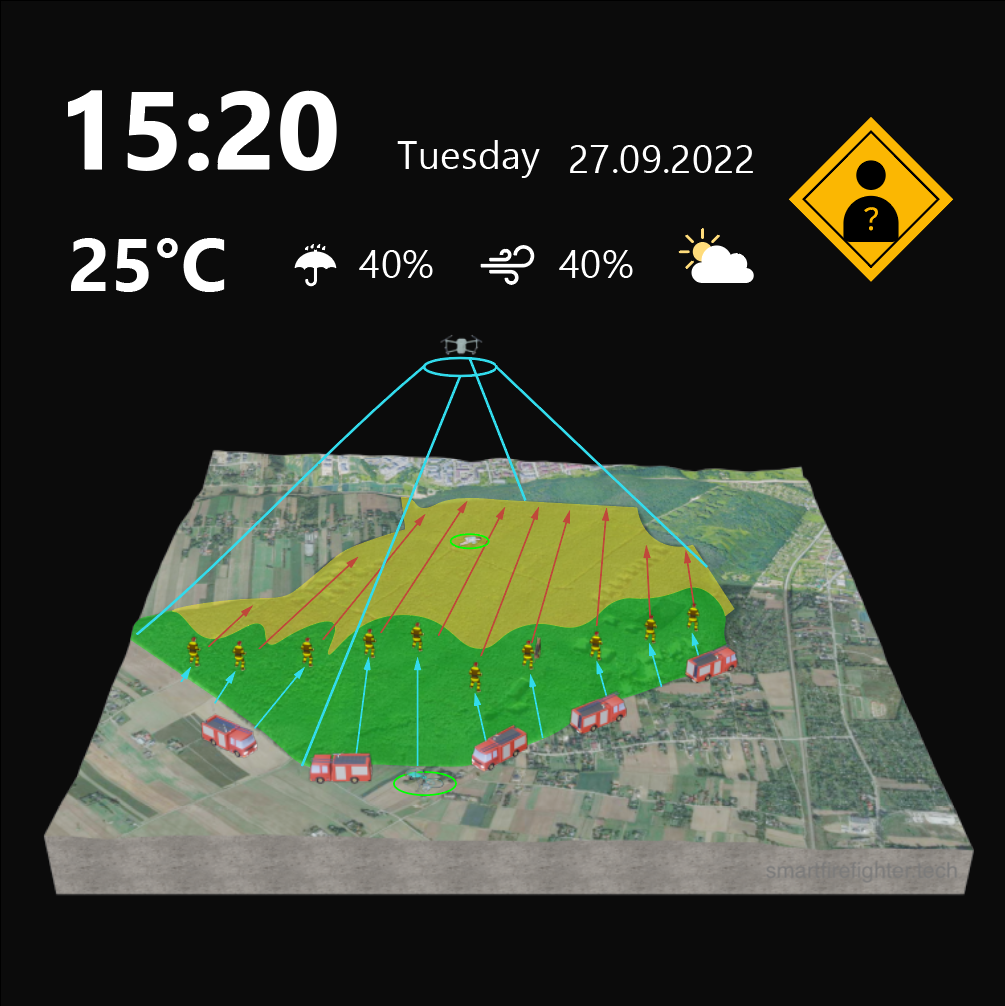technology in the service of humanity

It is important to be aware that any search for the missing persons is a large-scale operation, involving many services.
In general, the Police, as the lead unit in the implementation of the search for missing persons, command the site of operations, coordinates the cooperation of all services and is responsible for the entire operation.
However, it is standard that in situations when searching for missing persons (certain categories of reports) the Police turn to other entities such as the State and Volunteer Fire Departments, as well as search and rescue groups operating on an association basis for assistance in ongoing actions. In terms of specialized search and rescue units and firefighters, saving lives is a priority for them.
Not so long ago, the Fire Department assisted the Police using traditional methods such as tyralier, but now provides advanced, wide-ranging support measures including new search methods so-called quick threes/fours, groups with rescue dogs, drones, thermal imaging cameras and other specialized equipment or smartfirefighter’s technologies.
When requesting the dispatch of search services and the Fire Departments, a minimum of the most important must be provided, enabling immediate action to be taken at the scene and reducing response time.
The basic information includes:
- clear identification of the person sought (child or adult)
- a current color photograph (if possible)
- date and time of disappearance, circumstances of disappearance
- date and time of commencement of search activities by the police
- a brief description of the actions taken by the police (what actions were taken until the search services were dispatched)
- contact to persons directly in charge of the activities
- maps of the area to be searched, designated areas to be searched by firefighters and rescuers,
- type/characteristics of the area to be searched
On the other hand, supplementary information includes:
- name of the missing person
- description of the person (gender, age, height, weight, skin color)
- description of the person’s clothing (what he was wearing) and other items he may be carrying
- the person’s psycho-physical condition prior to disappearance (disabilities, mental and chronic illnesses, memory loss, etc.)
- whether similar situations have occurred in the past
- the last place and time the missing person was seen
- and whether there is a person familiar with the area, such as a forester, at the scene of the activity.
After receiving the details of the report, the data is analyzed and further action is taken based on it. In the case of a search, an accurate analysis of the data in hand greatly determines the work of the search and rescue service.
Every person has a set of relatively constant psychophysical characteristics, which are manifested in his behavior.
Thus, knowing these characteristics and studying some manifestation of his actions, it is possible to infer the appropriate rescue actions to be taken and implemented intentions based on psychological knowledge and other scientific fields (e.g., statistics, sociology, anthropology, biology, medicine, etc.).
AI-assisted, smartfirefighter’s systems, taking into account parameters such as gender, age, physical condition, disorders, diseases and other available physical and mental parameters of the person sought, weather and terrain conditions at the search site as well as the time elapsed since the disappearance, can make precise predictions about the scope and direction of the search.
In this way, it is possible with a high degree of probability to predict whether the person being searched for will be going in some chosen/known direction or rather circling, and what distance he/she is able to cover from disappearance.
After detailed, automatic, AI-assisted analysis and determination of search parameters, an effective action plan for the emergency services can be established.
Determine the strategy, divide into search groups, determine search directions and ranges, take into account the appropriate response to current and upcoming weather conditions, and properly plan and coordinate the work of rescuers conducting search operations.
Using data from GPS locators and smartfirefighter’s sensors, it is possible to precisely control the scope of the search, precisely determining the areas already searched by individual groups and the directions of further activities. The use of new technologies in this areasignificantly facilitates and accelerates the conduct of effective searches significantly increasing the chance of survival of the missing person.
The use of technology to plan the GPS positioning of rescuers and determine optimal search routes significantly facilitates conducting operations in wooded areas or on bodies of water (where it is difficult to have reference points in terms of the searched area).
Similar algorithms and devices for precise navigation (~1cm accuracy) have already been used successfully for a long time in various industrial fields, as well as, for example, in modern precision agriculture.
The safety of rescuers and other units should also be a primary consideration when conducting rescue and search operations.
On any incident it is crucial for fire department Safety Officers and Incident Commanders to know where their firefighters are at all times. Being able to keep track of crew assignments in real time helps fire chiefs make decisions that contribute to smooth operations.
More importantly, though, PPE devices and wearable technologies, plays an important role in ensuring firefighter safety and preventing responders from deaths.
On-scene smartfirefighter position and health parameters tracking equipment gives Incident Commanders using Command Center valuable information about progress during an emergency and helps to better respond to the current situation.
Additionally in case a firefighter becomes trapped or injured, Incident Commanders will know exactly where to go to rescue them, saving valuable minutes and seconds that could mean the difference between his life and death.
If it becomes necessary to call firefighters for extra help, GPS trackers in smartfirefighting can quickly send them the right location and transmit the emergency service’s positions.
With smartfirefighter systems operational in firefighting, the Command Center can automatically receive and manage this data in real-time as well as use them later for analysis and training purposes.
Additional sources:
https://bip.brpo.gov.pl/sites/default/files/Poszukiwania%20os%C3%B3b%20zaginionych%20-%20Aleksandra%20Wentkowska%20-monografia%202016.pdf
https://www.missingpersonsguide.com/ground-searches/
https://www.ukfrs.com/guidance/search/situational-awareness-search-missing-person